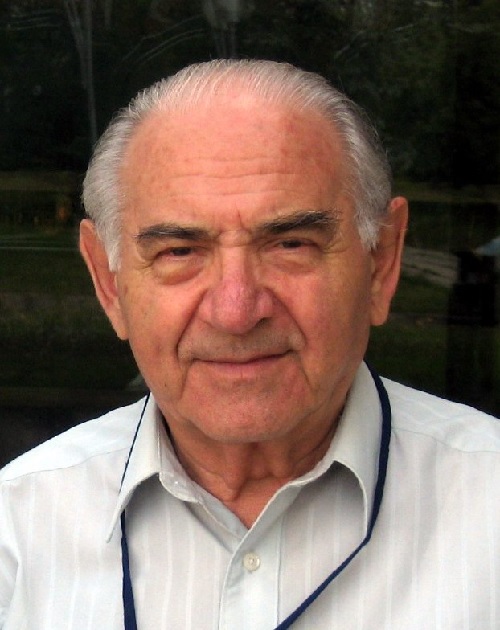- 66

A new scientific idea usually has a hard time finding its way. At first, it is dismissed by everyone. Venerable authorities say it's nonsense. After a while, the first doubts appear, and some people allow themselves to say that there may be some truth in it. A few years later, everyone said the idea was so obvious that everyone knew about it, and any student could have said it. I was told about this somewhat amusing evolution of human attitudes toward the new мany years ago by my then-supervisor, Isaac Bersuker, a prominent Moldovan scientist. However, at that time, I only guessed about Bersuker's outstanding qualities, and I was an ordinary post-graduate student among several of his students and collaborators. Later, my other senior colleagues also told me about the similar fate of new scientific ideas. The difficult fate of original ideas was not so rare, and such circumstances did not only happen to Beruker. But another of his remarks put the idea in a new light. According to Bersuker, scientific recognition is achieved by those who not only create new ideas but also have a strong character, able to defend the idea when everyone dismisses it and does not take it seriously. Years later, having become better acquainted with Isaac Bersuker's scientific work and learned about his difficult life path and the complex obstacles he overcame, I realized that the advice to his students was not accidental but part of his worldview. The bits of wisdom he generously shared with his students came from his own experience and were part of what we now call the Bersuker School.
In this respect, it is worth telling about one of the most striking scientific discoveries of Bersucker - his vibronic theory of ferroelectricity. From the early twentieth century, the phenomenon of spontaneous electric polarization attracted the attention of physicists and chemists as an example of spontaneous symmetry breaking. This phenomenon is most clearly manifested in barium titanate, where the change in dielectric constant reaches fifteen hundred times. In the early fifties of the last century, the famous physicist Lev Landau proposed a theory of superconductivity, and a few years later, with his student Vitaly Ginzburg, he applied a similar approach to describe ferroelectric phenomena. The Ginzburg-Landau theory perfectly explains the thermodynamic properties of many ferroelectrics, including barium titanate. In the early sixties, the same theory was proposed by the brilliant American physicist Philip W. Anderson. It should be noted that in different years, all the listed creators of the theory of ferroelectricity received Nobel Prizes.
The problem seemed to be solved, which should be the story's end. By the way, even today, 60 years later, many textbooks describe ferroelectricity phenomena based on the phenomenological theory of Ginzburg-Landau-Anderson. At the same time, like any phenomenological theory, it has a descriptive character, not explaining the causes of the ferroelectricity phase transition and not revealing its microscopic mechanism. At that time, at the end of the fifties, Isaac Bersucker was barely over thirty years old. At that time, he was fascinated by the Jahn-Teller effect, a microscopic mechanism of spontaneous symmetry breaking of electronically degenerate molecules. Another logical step - Bersucker suggested that a similar symmetry breaking is possible for nondegenerate states in the case of strong vibronic mixing with excited states. Today, it is commonly called the pseudo-Jahn-Teller effect. Qualitative estimates confirmed the possibility of a similar phenomenon in barium titanate. It should be noted that this was the time of the Cold War, when all contacts with the West, including scientific information, were extremely difficult. Some studies of the pseudo-Jahn-Teller effect were also conducted abroad, but Bersucker could learn about them with a great delay, a year or two later. Parsing the scientific archives, one can see that at the time, no one in the West went so far in studying the pseudo-Jahn-Teller effect, and no one thought to apply this theory to explain ferroelectricity. By the end of 1964, Bersuker had created a scientific manuscript on the microscopic mechanism of ferroelectricity and sent it to the Journal of Experimental and Theoretical Physics, the central Soviet journal of theoretical physics.
Bersuker's article was not accepted for publication. Several years later, in a coffee-break conversation at one of the scientific conferences, Bersucker was objected to by Lev Gor'kov, a former student of Landau, one of the co-authors of the phenomenological theory of Ginzburg-Landau. "Pardon me," said Gor'kov, "in barium titanate, the ground state is an orbital singlet, and the energy gap to the nearest excited energy level is huge, two electronVolts. What vibronic mixing of these states can we talk about here?!" The young Lev Gor'kov had already become a corresponding member of the USSR Academy of Sciences at that time and, by all accounts, was the most recognized authority in Soviet and world theoretical physics. His argument, it should be admitted, was strong. In the theory of the pseudo-Jahn-Teller effect, a relatively small energy gap between the mixed energy levels is a necessary condition for instability.
Bersuker's theory included one more component to which Gor'kov objected. In Bersuker's theory, spontaneously occurring dipole moments have a local character, and the phase transition is of the order-disorder type. The Ginzburg-Landau-Anderson theory did not require any disorder. Ferroelectricity was explained as the result of a displacement of two sublattices on the scale of the whole crystal. And yet, Bersucker stood his ground. In his opinion, the vibronic mechanism in barium titanate is so strong that it can overcome a significant energy gap and is the cause of the spontaneous symmetry breaking.
Today, such a dispute could easily be resolved by direct calculation on an ordinary personal computer. The evaluated potential energy surface would show the presence or absence of instability. Looking ahead, I will say that such calculations of the octahedral complex [TiO6] were carried out repeatedly with increasing accuracy. Each calculation performed confirmed Bersucker's instability assumption. But sixty years ago, no one could even imagine such a computer. Bersuker's theory was based on his intuition supported by a deep understanding of the nature of chemical bonding.
Bersuker translated the manuscript rejected by the Soviet journal into English and submitted it to Physica Status Solidi, a physics journal published in the GDR. And again, he failed. Bersucker's article was rejected. As it is easy to guess, in both journals, Soviet and German, the article did not pass the peer-reviewing filter. The Ginzburg-Landau-Anderson theory was such an authoritative factor and had such strong support in the scientific community that Bersuker's alternative theory was dismissed; no one took it seriously. In this moment of universal rejection of Bersuker's idea, the strong character of the author played an important role. Bersucker knew he was right, and no scientific authority could change his unshakable confidence in the correctness of his arguments. Having reduced the paper to the size of a short communication, Bersucker submitted the manuscript to a third journal, Physics Letters, where it was finally published in 1966.
As written in old movies, twenty years passed. Real opportunities for calculation of the electronic structure of the octahedral complex [TiO6] emerged, which Bersuker used in his Laboratory of Quantum Chemistry of the Institute of Chemistry of Moldova. Several scientific groups in the United States and Germany performed similar calculations with even higher accuracy. They all confirmed the instability of the octahedral complex [TiO6] exactly as Bersucker predicted. The potential energy surface of the titanium (IV) complex has a maximum in the center of the octahedron; the titanium ion displaces off the center to form a more stable covalent chemical bond with neighboring oxygen atoms. However, the main support for Bersuker's theory came not from the theorists but from the experimenters. Various scientific centers conducted numerous studies and obtained experimental confirmation of Bersuker's theory. The facts that did not fit into the old theory of sublattice shift were accumulated and perfectly explained by Bersuker's vibronic theory.
At first, doubts arose, and then confidence was gained that Bersucker's theory correctly described the properties of barium titanate and related perovskite ferroelectrics. Among those who recognized the correctness of Bersuker was Nobel Prize winner K. A. Muller, who devoted several decades of his research life to the experimental study of barium titanate. This acceptance is evidenced by his two visits to Chisinau to discuss further plans for his scientific research with Bersuker. Today, several monographs, dozens of reviews, and hundreds of scientific articles have been written about Bersuker's vibronic theory of ferroelectricity.
Isaac Bersuker was born in Chișinău in 1928. In a few days, he will be 97 years old. Between these dates is a long life filled with numerous scientific ideas, creative revelations, and discoveries. They demanded a firm character and a clear conviction in the triumph of scientific truth. None of his ideas or discoveries took their place in the world's scientific treasury without a persistent struggle for the right of these ideas to exist and be accepted.
Bersuker's childhood was not easy. Five children were in a low-income family with a single income: the father was a carpenter. Chisinau experienced difficult events such as the change of state, World War II, post-war famine, and devastation. When Isaac was a teenager during the war, the family was evacuated to a small Azerbaijani village. Instead of studying at school, they had to work on a collective farm, herding sheep and working in the fields. In post-war Chișinău, Isaac found himself without a high school education. He declared, "The most important decision I made in 1945, at seventeen when our family returned to Kishinev from evacuation, was to continue my studies and devote myself to scientific research. It determined my life path and the fate of my subsequent children and grandchildren, my students and pupils." He finished his high school education in two years and received his certificate. Then, his education continued at the Department of Physics and Mathematics of the State University of Chișinău, post-graduate studies in Leningrad, and establishment and management of the Laboratory of Quantum Chemistry at the Institute of Chemistry of the Moldovan Academy of Sciences.
One can be amazed by Isaac Bersuker's remarkable longevity - his physical health and his creative activity. In his 97 years, Isaac Bersuker has kept his enquiring mind, is full of ideas, writes scientific reviews, and is ready to publish new monographs. We wish Isaac Bersuker good health, new creative successes, and long years, up to 120. Happy Birthday, dear Isaak Borisovich; keep up the good work. You do it well.
Victor POLINGER, PhD
Department of Chemistry, University of Washington
Seattle, Washington, USA

